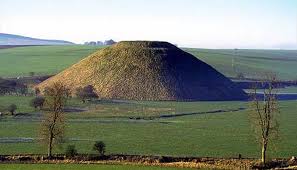Tags
Archaeology, English Heritage, Museum, News, Wessex, Wiltshire
Last week, we reported on Dr Leary’s talk about his team’s work at Marden henge in the Vale of Pewsey. Just part of the work involves the study of the remains of the hill within the henge, called Hatfield Barrow, now flattened.
It had been excavated by Sir Richard Colt Hoare in the early nineteenth century, found to be largely empty, and when it collapsed into the excavation hole it was levelled by the farmer. The modern excavations of the remains show this mound was contemporary with Silbury, though smaller than, (the largest pre-historic mound in Europe), built circa BC 2 400. Dr Leary was sufficiently intrigued by this to consider an excavation of another, apparently similar, mound in the area, Marlborough Mound in the grounds of Marlborough School.
Legend has it that Marlborough Mound contained the bones of Merlin, and it certainly was the motte on which the Norman keep of Marlborough Castle was built around AD 1100. Was it older than this? With considerable support from the College itself, and from other agencies, Dr Leary was able to co-ordinate the extraction of cores from the mound which, with carbon dating by English Heritage, showed that the mound was also originally built c BC 2 400. Three such mounds in one small area!

Silbury – the largest of the three mounds mentioned here
For Jim Leary, this raised the question – what about the other mounds, scattered around the country, and most, like Marlborough, assumed to be Norman mottes?
He was able to do similar research on a number. The audience at the museum talk waited with bated breath as the slide with time-lines went up on the screen, to reveal….. No, all the mounds further investigated were, as originally thought, about one thousand years old, ie Norman. Except one. It wasn’t circa 5 000 years old, but Iron Age (just over two thousand years old). And the only known example in this country.
It is at Skipsea in Yorkshire. On the Continent these Iron Age hills were the wealthy ‘seats’ of nobility, always associated with enclosures which, in turn, always show, through finds, amazing cultural links with far-flung places. Does Skipsea have an enclosure? Oh yes……. it does. What a time to be in archaeology!
See the Round Mounds Project for more.
